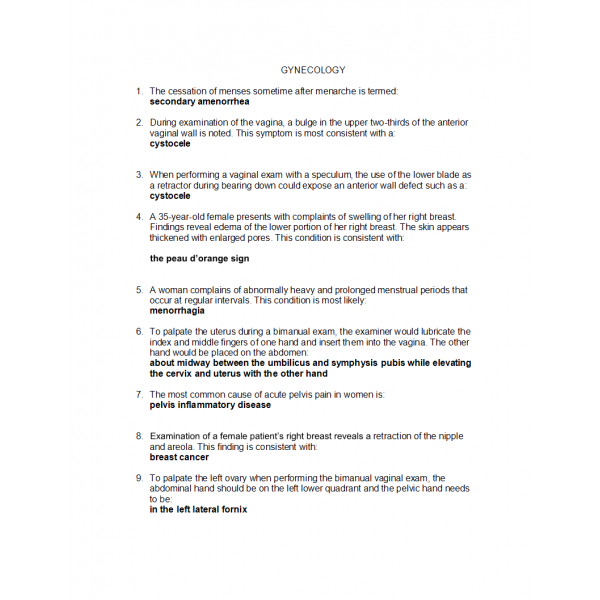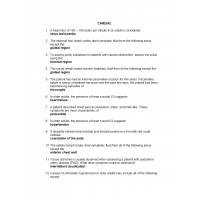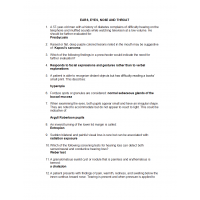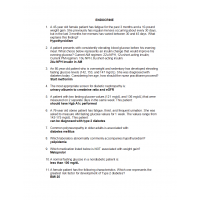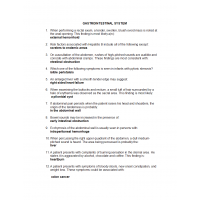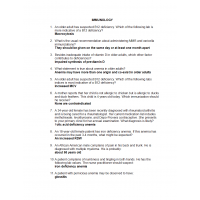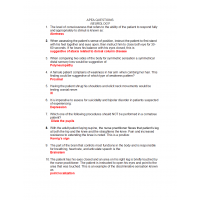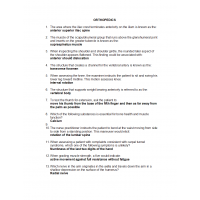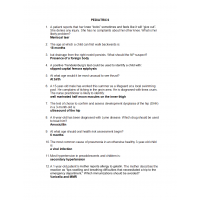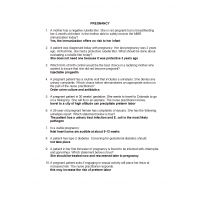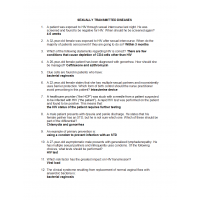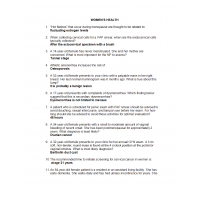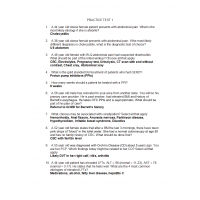NSG 6440 APEA Exam - GYNECOLOGY
NSG 6440 APEA Exam GYNECOLOGY
1. The cessation of menses sometime after menarche is termed:
2. During examination of the vagina, a bulge in the upper two-thirds of the anterior vaginal wall is noted. This symptom is most consistent with a:
3. When performing a vaginal exam with a speculum, the use of the lower blade as a retractor during bearing down could expose an anterior wall defect such as a:
4. A 35-year-old female presents with complaints of swelling of her right breast. Findings reveal edema of the lower portion of her right breast. The skin appears thickened with enlarged pores. This condition is consistent with:
5. A woman complains of abnormally heavy and prolonged menstrual periods that occur at regular intervals. This condition is most likely:
6. To palpate the uterus during a bimanual exam, the examiner would lubricate the index and middle fingers of one hand and insert them into the vagina. The other hand would be placed on the abdomen:
7. The most common cause of acute pelvis pain in women is:
8. Examination of a female patient’s right breast reveals a retraction of the nipple and areola. This finding is consistent with:
9. To palpate the left ovary when performing the bimanual vaginal exam, the abdominal hand should be on the left lower quadrant and the pelvic hand needs to be:
10. A female patient presents with gray, thin, malodorous (fishy) vaginal discharge. These symptoms are most consistent with:
11. A twenty-year-old female complains of a milky discharge bilaterally from her breasts. This suggests:
12. Upon examination of the vagina, a tense, hot, very tender abscess with labial swelling is noted. This finding is most consistent with a:
13. Upon examination of the vagina, the entire anterior vaginal wall, together with the bladder and urethra create a bulge. This condition is most consistent with a:
14. Upon examination of the vagina, a small, red, benign tumor is noted at the posterior part of the urethral meatus. This finding is most consistent with a:
15. The shiny, pink area located around the cervical os is known as:
16. During the speculum exam of the cervix the speculum is maintained in an open position by:
17. The vaginal mucosa lies in transverse folds called the:
18. When examining the cervix, a bright, red, soft and fragile lesion is noted on the cervical surface. This finding is consistent with:
19. Daughters of women who took Diethylstilbestrol (DES) during pregnancy are at a high risk for developing all of the following abnormalities except:
20. In a female diagnosed with a first-degree uterine prolapse, the cervix:
21. Upon examination of the vagina, a swollen red ring is noted around the urethral opening. This finding is most consistent with a:
22. The most common causes of sexual problems in females are related to:
23. Upon examination of the cervix, an irregular cauliflower-like growth was noted around the cervical os. This finding is most suggestive of:
24. A woman complains of the infrequent menses with intervals greater than 35 days. This condition is termed:
25. The most common type of hernia in women is the:
26. When performing a rectal exam on a female, a hard nodular rectal “shelf” is palpable at the tip of the examiner’s finger. This finding is suggestive of: metastatic tissue in the rectouterine pouch
27. A woman complains of experiencing uterine bleeding between expected menstrual cycles. This condition is termed:
28. When performing a vaginal exam with a speculum, the use of the upper blade as a retractor could expose a:
29. A 45-year-old female presents to the nurse practitioner with complaints of postcoital bleeding (greater than spotting) unrelated to the menstrual cycle. What is most likely the cause?
30. The deep red area located around the cervical os is known as:
31. When performing an examination of the external genitalia of a female patient, a small, firm, round cystic nodule in the labia is identified. This lesion is most consistent with:
32. Fixed flattening of the nipple suggests:
33. Causes of post-menopausal bleeding typically include all of the following except:
34. When performing the bimanual vaginal exam, uterine enlargement is noted. This enlargement could suggest:
35. Upon examination of the vagina, a bulge is noted in the lower posterior wall of the vagina. This finding is most consistent with a:
36. Menopause is diagnosed in a woman who has experienced amenorrhea for:
37. When performing a bimanual exam of the vagina, the examiner should lubricate the index and middle fingers of a gloved hand. From a standing position, the fingers should be inserted into the vagina while exerting pressure primarily:
38. A woman complains of experiencing frequent menses with intervals of fewer than 21 days. This condition is termed:
39. When palpating the cervix during the bimanual exam, cervical motion tenderness (chandelier sign) is noted. This tenderness could be suggestive of:
40. To palpate an indirect inguinal hernia in women, have her stand and palpate in the labia majora and:
41. Chronic pelvic pain refers to pain that does not respond to therapy and:
42. Pelvic floor muscle weakness may be due to all of the following except:
43. When performing a bimanual vagina exam, a solid, nodular-like lesion is palpated over the right ovary. This finding is most consistent with:
44. When examining the cervix, a translucent nodule is noted on the cervical surface. This finding is consistent with:
45. Primary dysmenorrhea results from:
46. If performed correctly and in a timely fashion, which one of the following is most definitive for the diagnosis of breast cancer?
47. When performing the bimanual vaginal exam, a nodule on the anterior uterine surface could suggest a/an:
48. In a female diagnosed with a third-degree uterine prolapse, the cervix:
49. In a female diagnosed with a second-degree uterine prolapse, the cervix:
50. When do ovaries become non-palpable after menopause?
51. When performing a bimanual vaginal exam, a smooth and rather compressible non-tender lesion is palpated over the right ovary. This finding is most consistent with:
52. Chronic pelvic pain may be secondary to all of the above except:
53. When preparing to perform a pelvic exam in an older female, vaginal atrophy is noted. Due to this finding, the speculum:
54. A female patient has a history of a retroverted uterus. This condition refers to:
55. When performing a breast exam, a mobile mass becomes fixed when the arm relaxes. This suggests that the mass is:
56. When discussing the female anatomy, the introitus is also known as the:
57. If the urethritis or inflammation of the paraurethral glands is suspected in a female patient, the index finger should be inserted into the vagina and:
58. The most important risk factor for cervical cancer is:
59. In which of the following situations would it be difficult for the examiner to palpate an ovary during the bimanual vaginal exam?
60. The cessation of menses sometime after menarche is termed:
61. To assess pelvic floor muscle strength during the bimanual vaginal exam, have the patient squeeze around the inserted fingers for as long as possible. To consider full strength, snug compression should last for:
62. Upon examination of the cervix, a yellow drainage is visible around the cervical os. This finding is most likely suggestive of:
63. In female patients with dyspareunia, superficial pain is most likely related to all of the following except:
64. An ulcerated vulvar lesion in an elderly woman may indicate:
65. A female patient presents with a white and curd-like thin vaginal discharge. This discharge is most consistent with:
66. Urethritis in a female patient may arise from all of the following organisms except:
67. A female patient presents with a profuse, yellowish, green vaginal discharge that is malodorous. This vaginal discharge is most consistent with:
68. Indications for performing a rectovaginal exam include all of the following except to:
69. The most common causes of sexual problems in females are related to:
70. Retraction of the nipple and areola suggest:
71. Which factor listed below increases the risk of ectopic pregnancy?
72. Which clinical manifestations of an ectopic (fallopian tube) pregnancy typically appear)?
73. A pregnant patient is 30 weeks’ gestation. She wants to travel to Colorado to go on a hiking trip. She will fly in an airplane. The nurse practitioner knows:
74. When should folic acid be initiated in a female patient contemplating pregnancy if she is not taking it at this time?
75. A 66-year-old African American female has multiple risk factors for osteoporosis. Which choice listed below is NOT a risk factor for osteoporosis?
| Institution & Term/Date | |
| Term/Date | South University |
-
$30.00

